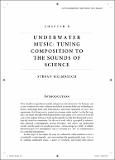Underwater Music: Tuning Composition to the Sounds of Science
Author(s)
Helmreich, Stefan
Downloadhelmreich_underwater_music.pdf (1.159Mb)
OPEN_ACCESS_POLICY
Open Access Policy
Creative Commons Attribution-Noncommercial-Share Alike
Terms of use
Metadata
Show full item recordAbstract
This article attempts to audit underwater music. There are two primary venues for underwater music: field settings of the ocean and lab settings of swimming pools. For the field tradition, underwater music emerges from the noise of the Cold War, revealing the songs of whales and harboring evidence of global warming, of sea creatures under stress, etc. For the lab tradition, the pool is a stage to realize the aesthetic of Cagean modernism. It becomes a space to play with meanings of water. While the field setting is “wild” and entangled with nonhuman sounds and the lab setting is more social, cultural, or anthropocentric, artists working in both settings seek to evoke an “immersive” experience. In both settings the transductive properties of water must be managed to invoke water as a material accomplice in this enterprise, this aim of soaking listeners in the sublime surround of sound submerged.
Date issued
2011-12Department
Massachusetts Institute of Technology. Anthropology Program; Massachusetts Institute of Technology. Department of HumanitiesJournal
The Oxford Handbook of Sound Studies
Publisher
Oxford University Press
Citation
Helmreich, Stefan. “Underwater Music: Tuning Composition to the Sounds of Science.” Oxford Handbooks Online (December 2, 2011).
Version: Original manuscript
ISBN
9780195388947